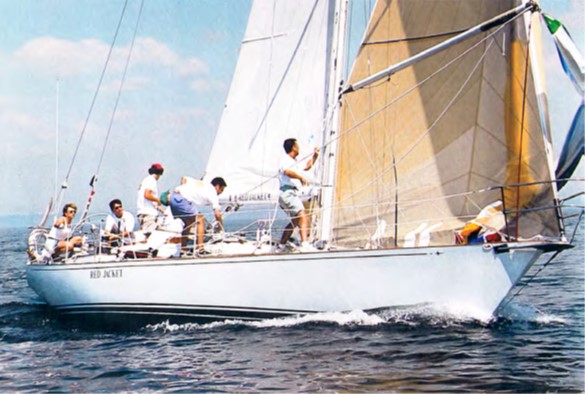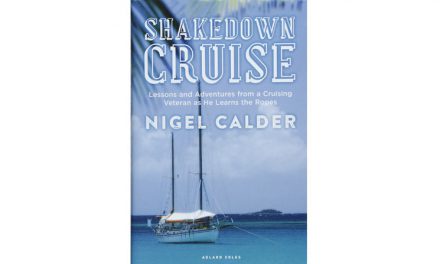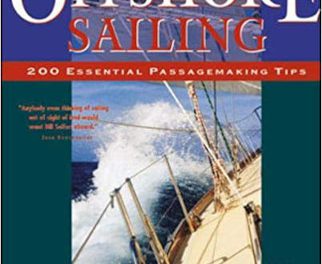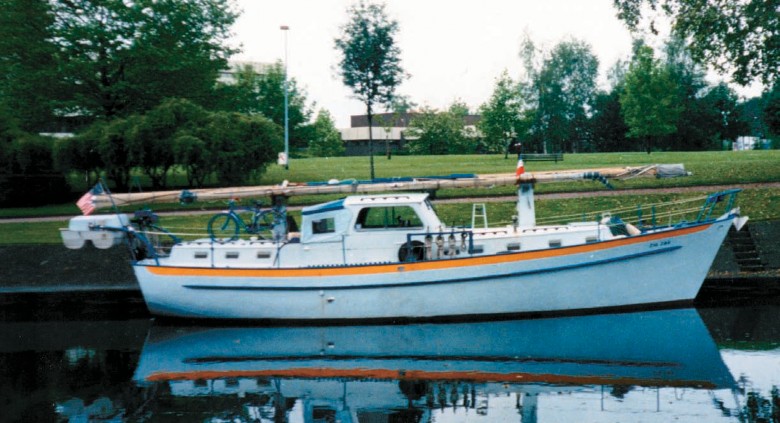Arguably Canada’s most influential racing boat, Red Jacket broke all the molds.
Issue 140: Sept/Oct 2021
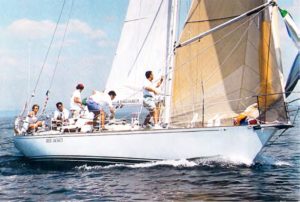
Racing under owner Paul Phelan, Red Jacket shows her winning form. Credit: Bryan Gooderham.
The name Red Jacket invokes instant pride and recognition among knowledgeable Canadian sailors. She not only beat all U.S. competitors in the prestigious Southern Ocean Racing Conference (SORC) in Florida in 1968, but in doing so she launched the international reputation of Canadian designers and builders, prompting the founding of C&C Yachts. The Canadian company would dominate the North American sailboat industry for the next 20 years with production facilities in three countries.
Through the generosity of Peter Milligan, her late owner, this Canadian sailing legend will soon reside at the Marine Museum of the Great Lakes at Kingston.
What were the keys to Red Jacket’s success? What made her unique, and what made her a superstar? The answers to these questions lie in three areas: design, construction, and the people involved in her creation and campaigning.
The Design
Red Jacket was designed in 1965 for Canadian contractor Perry Connolly by the emerging yacht design firm of Cuthbertson & Cassian Ltd. of Port Credit, Ontario.
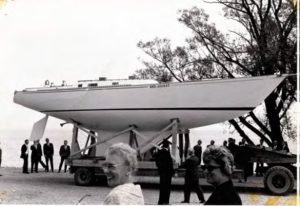
Red Jacket at her launch in May 1966 showing her separate keel and all-movable rudder, both radical for their time. Credit Mark Bruckmann.
The legend goes that between the second and third periods of a Toronto Maple Leafs hockey game, Connolly asked his good friend, George Cuthbertson, to design the “meanest, hungriest 40-footer afloat.”
Cuthbertson and his associate George Cassian took that instruction to heart. Red Jacket’s underwater profile used a separate keel and an all-movable spade rudder, reducing her wetted surface, increasing the efficiency of her “foils,” and improving maneuverability and control. This was in sharp contrast to the full keels with attached rudders that had persisted in offshore yacht design for too many years. This split configuration is now the norm, but in 1966 when she was launched, it was definitely avant-garde.
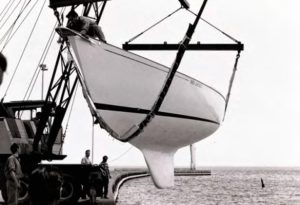
Red Jacket at her launch ceremony in May 1966. The aluminum “hair pin” bowsprit helped save weight forward. Credit Mark Bruckmann.
Above the waterline, the designers focused on weight reduction and improved efficiency. They particularly targeted weight reduction in the ends of the hull to reduce the pitching moment for smoother sailing in waves. They reduced the traditional longer overhangs by using a reverse transom aft and an aluminum “hair pin” bowsprit forward. They improved rig efficiency by reducing drag with the use of shrouds that crossed internally to the other side of the mast.
Engine weight was cut by installing a rotary Wankel engine, which ultimately proved unreliable in a marine environment. The interior was stark, with no accommodations forward of the mast to allow for better sail storage and to further reduce the weight in the ends of the boat.
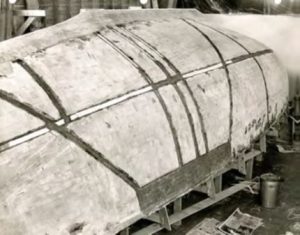
Balsa core applied to the inside skin on a hull plug. Note the areas of core removed to allow installation of solid fiberglass “strapping,” a technique eliminated in all subsequent cored construction at C&C. Credit Mark Bruckmann.
The Construction
After all the weight-shaving in Red Jacket’s design, the choice of construction proved to be the ultimate attempt to keep her as light as possible. In 1966, wood, steel, and aluminum were the popular materials for racing yacht construction. Early fiberglass was being used in smaller, higher-volume production boats but seldom in competitive custom one-off race yachts. Red Jacket turned that practice on its head by employing an engineered composite hull construction using a lightweight, end-grain balsa core sandwiched between two load-bearing engineered fiberglass skins. This was the first time this had been done in North America, and it reduced weight with a substantial increase in stiffness and no loss in strength.
The technique was so new in racing yacht construction that Red Jacket’s builder, Erich Bruckmann, had never built a boat like this before, but he would soon become the master of the method and build some of the finest boats in the world in the C&C Yachts Custom division. And while it was unique at the time, sandwich-cored construction soon became the norm in all performance composite structures, from aircraft to wind turbine blades.
The People
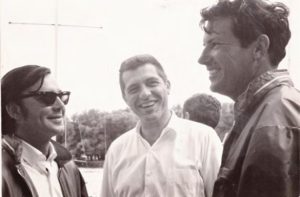
The brains behind the creation of Red Jacket (L to R), George Cassian, George Cuthbertson, and Perry Connolly. Credit Mark Bruckmann.
The people involved in Red Jacket—her owner, designers, builder, and crew—had been working together on a number of other projects for many years before her creation. This was a classic example of the 10,000-hour theory of creativity. Red Jacket was innovative and revolutionary for her day, but she did not come out of thin air.
Cuthbertson and Connolly had known each other since their teens sailing in Toronto. When Connolly returned to sailing in the early 1960s, he bought an imported steel CN-35 yawl from Cuthbertson and Cassian and raced her extensively and successfully. In 1964, Cuthbertson and Cassian designed, and Bruckmann built, the strip-plank, 42-foot Thermopylae for local sailing rival Gordon Fisher. Thermopylae so dominated racing on Lake Ontario that Connolly asked Cuthbertson to pull out the stops and design the next generation of offshore racer specifically to beat her. He chose the name Red Jacket to underline the rivalry between the two boats; Fisher had named Thermopylae after a famous clipper ship, and Connolly followed suit with Red Jacket.
(Fisher would become a watch captain on Red Jacket in the 1968 SORC, and Fisher and Connolly would become two of the three syndicate members behind the creation of the C&C- designed, Bruckmann-built Manitou to win the 1969 Canada’s Cup; they shared helmsmen duties during the series. Cuthbertson and Connolly remained lifelong friends. They died within a week of each other.)
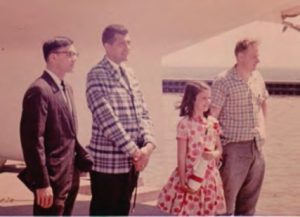
George Cassian, George Cuthbertson, Perry Connolly’s daughter Shelagh, with champagne, and Erich Bruckmann at Red Jacket’s launching in May 1966. Credit Brion Jorgenson.
After Red Jacket’s launch in May 1966, she too dominated racing on Lake Ontario, winning 11 of her 13 races that season. That success prompted Connolly to follow the advice of American Jim McHugh, owner of the not-yet-finished Cuthbertson-designed and Bruckmann-built Inferno II, to combine their crews and enter Red Jacket in the 1967 SORC, a series of five offshore races in Florida considered the World Series of yacht racing.
She lost the overall prize by one bad race, the all-important, high-scoring Miami-to-Nassau Race, and dropped from first to sixth in her class. She came so close to winning that Connolly decided to return the following year. Her all-Canadian crew in the 1968 SORC was made up of others who had been involved in this process, notably Gordon Fisher.
Red Jacket had built on all the lessons learned from her predecessors and took it to the next level. These are people who had worked together in close collaboration for many years perfecting the ultimate ocean racer. With Red Jacket, their time had come.
C&C Yachts
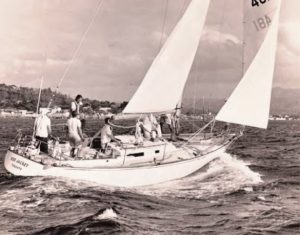
Red Jacket with her mixed Canadian and American crew racing to Jamaica after the 1967 Southern Ocean Racing Conference. Credit George Cuthbertson.
Red Jacket’s overall win at the 1968 SORC led directly to the public stock offering that resulted in the creation of C&C Yachts in 1969, and that, too, is the stuff of sailing legend. The design firm of Cuthbertson & Cassian joined with the three Ontario builders producing their designs in fiberglass–Bruckmann Manufacturing, Hinterhoeller Yachts, and Belleville Marine–to create a combined design, manufacturing, and marketing entity.
Racing wins continued with other Cuthbertson & Cassian-designed, Bruckmann-built custom race boats, notably Manitou winning the Canada’s Cup in 1969, and the continued success in the SORC, where C&C boats won overall and three of the five divisions in 1972. Cuthbertson would put down his drawing pencil, handing design responsibilities to Rob Ball, and become president of C&C in 1973. Connolly would later manage the Rhode Island subsidiary of C&C and eventually Boston Whaler and Hinterhoeller Yachts, while Bruckmann continued to produce masterpieces in yacht construction throughout his long career.
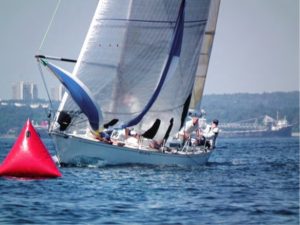
Red Jacket continuing her winning ways in the 2011 LYRA Regatta at Port Credit Yacht Club with her longtime sailing master Bryan Gooderham at the helm. Bryan has helmed and cared for Red Jacket for over 25 years under the ownership of Paul Phelan and Peter Milligan.
It is now 55 years since Red Jacket’s launching, and sadly, very few of the people who created her are still with us. Peter Milligan was her most recent owner, the last of a number of individuals who cared for and revered this remarkable piece of Canadian sailing history, while at the same time continuing her winning ways on home waters. He always said he felt more like Red Jacket’s custodian than her owner, so he stipulated in his will that she should be donated to the Marine Museum of the Great Lakes at Kingston upon his death, which came far too early.
Milligan chose the marine museum as her final home largely because Cuthbertson had already donated his entire drawing collection up to 1973—including the Red Jacket drawings—to the museum. Also, Tim Jackett of Fairport Marine in 2012 donated all the C&C drawings from 1974 to 1996, when the C&C assets were purchased by Fairport Marine in Ohio (see “Drawing on History,” July/ August 2021). The marine museum is also the home of the Canadian Sailing Hall of Fame in which George Cuthbertson was an early inductee, and it will be initiating the Register of Historic Canadian Sailing Craft. Red Jacket, of course, will be the first entry.
The plan is that Red Jacket, in her new home in Kingston, will continue to sail, allowing as many sailors as possible to try their hand at the wheel and trimming the sheets of this remarkable piece of Canadian sailing history.
(A version of this story first appeared in Thousand Islands Life magazine in April 2021.)
Good Old Boat Technical Editor Rob Mazza is a mechanical engineer and naval architect. He began his career in the 1960s as a yacht designer with C&C Yachts and Mark Ellis Design in Canada, and later Hunter Marine in the U.S. He also worked in sales and marketing of structural cores and bonding compounds with ATC Chemicals in Ontario, and Baltek in New Jersey.
Thank you to Sailrite Enterprises, Inc., for providing free access to back issues of Good Old Boat through intellectual property rights. Sailrite.com

